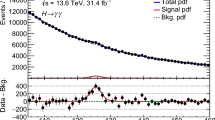Abstract
The predictions of Drell–Yan production of low-mass lepton pairs, at high rapidity at the LHC, are known to depend sensitively on the choice of factorization and renormalization scales. We show how this sensitivity can be greatly reduced by fixing the factorization scale of the LO contribution based on the known NLO matrix element, so that observations of this process at the LHC can make direct measurements of parton distribution functions in the low x domain; x≲10−4.





Similar content being viewed by others
Notes
Actually our approach is rather close to the k t -factorization method. Using the known NLO result we account for the exact k t integration in the last cell, adjacent the LO ‘hard’ matrix element (describing heavy photon emission), while the unintegrated parton distribution is generated by the last step of the DGLAP evolution, just like the prescription proposed in [5, 6].
Strictly speaking, z is the ratio of the light-cone momentum fraction carried by the ‘daughter’ quark to that carried by the ‘parent’ gluon, \(z=x^{+}_{q}/x^{+}_{g}\).
We use the computer code Vrap of Ref. [7].
Recall that the subtractions of the contribution generated by the NLO DGLAP evolution convoluted with the LO matrix element from the exact NNLO matrix element include the NLO splitting functions. Therefore we can convolute the known NNLO coefficient functions, C NNLO, with either the NLO or NNLO PDFs, but not with the LO PDF; in the latter case we need to recalculate the NNLO matrix element.
In the case of Q 0→0 we come back to δ-functions at the x values given by (10).
Recall that starting the evolution from Q 0=1 GeV more than 90 % of the Drell–Yan cross section is described by the gq→γ ∗ q subprocess, and so will probe g(x 2)q(x 1), see Fig. 4.
See for example Ref. [13].
References
A.D. Martin, W.J. Stirling, R.S. Thorne, G. Watt, in Proc. of DIS2008, London (2008), p. 30. arXiv:0808.1847
E.G. de Oliveira, A.D. Martin, M.G. Ryskin, Eur. Phys. J. C 71, 1727 (2011)
LHCb Collaboration, Phys. Lett. B 694, 209 (2010)
LHCb Collaboration, private communication
M.A. Kimber, A.D. Martin, M.G. Ryskin, Phys. Rev. D 63, 114027 (2001)
A.D. Martin, M.G. Ryskin, G. Watt, Eur. Phys. J. C 66, 163 (2010)
C. Anastasiou, L.J. Dixon, K. Melnikov, F. Petriello, Phys. Rev. D 69, 094008 (2004)
A.D. Martin, W.J. Stirling, R.S. Thorne, G. Watt, Eur. Phys. J. C 63, 189 (2009)
H.-L. Lai et al., Phys. Rev. D 82, 074024 (2010)
R.D. Ball et al. (NNPDF Collaboration), Nucl. Phys. B 849, 296 (2011)
R.D. Ball et al. (NNPDF Collaboration), Nucl. Phys. B 855, 153 (2012)
S. Alekhin, J. Blümlein, S. Moch, arXiv:1202.2281
G. Fai, J.-w. Qiu, X.-f. Zhang, Phys. Rev. C 71, 014901 (2005). arXiv:hep-ph/0409003
Acknowledgements
We thank Ronan McNulty for useful discussions. EGdO and MGR thank the IPPP at the University of Durham for hospitality. This work was supported by the grant RFBR 11-02-00120-a and by the Federal Program of the Russian State RSGSS-65751.2010.2; and by FAPESP (Brazil) under contract 2011/50597-8.
Author information
Authors and Affiliations
Corresponding author
Rights and permissions
About this article
Cite this article
de Oliveira, E.G., Martin, A.D. & Ryskin, M.G. Drell–Yan as a probe of small x partons at the LHC. Eur. Phys. J. C 72, 2069 (2012). https://doi.org/10.1140/epjc/s10052-012-2069-z
Received:
Revised:
Published:
DOI: https://doi.org/10.1140/epjc/s10052-012-2069-z




